Culture in Aichi
The Okumikawa Hana Matsuri
What is the Hana Matsuri?

The Hana Matsuri, a festival brought to the Okumikawa area during the end of Kamakura and Muromachi periods by warrior monks from Kumano and priests from Kagahakusan, takes place throughout the night, accompanied by chants of “teehohe, tehohe!" This event is a type of Shimotsuki Kagura used to invoke the rejuvenation of the sun's powers around the time of the winter solstice. This ritual performance has a history spanning more than 700 years and continues to take place today in the Tenryu River region.
The festival is thought to have originally centered on yutate (the water-boiling ritual) and kiyome (purification), but it came to include elements borrowed from the Ise Kagura and Suwa Kagura as the locals expanded the festival, likely approaching its modern form about 400 years ago.
Back then, the festival was called Okagura, and it was a magnificent performance that consisted of 130 ritual dance sessions spanning 7 days and 7 nights. Due to its great scale, it required an enormous amount of money and effort, so 100 ryo of gold (about 3.75 kg in total) and 100 bales of white rice (about 6,000 kg in total) would be set aside, with more stored in Kagura-bayashi Forest in case that wasn't enough. People from several areas would get together every 7 or 20 years to hold this performance, but being such a major event, today's Hana Matsuri has been shortened, with the Okagura condensed into a one-day, one-night festival. Why the Okagura was renamed the Hana Matsuri is still a mystery, and there are ten or so different explanations regarding the origin of the name “Hana," which in Japanese is written with a character that means “flower".
The festival begins with the cleansing of the hanayado (ritual site), and continues around the clock with the kami-mukae (god-welcoming ritual); yutate (the water-boiling ritual); the myodo dance; the youth dance; the young children's dance; the oni (friendly Japanese ogre) dance ; divine blessings from the Negi (priest), Miko (shrine maidens) and Okina (old men) spirits; the boys' dance; yubayashi (the hot-water-cleansing ritual); and the kamigaeshi (god-returning ritual) with no breaks in between.
This festival, which includes the myriad spirit summoning ritual, shoganjoju prayers (entreaties to the gods), the warding off of misfortune, and prayers for the rebirth purification ritual, was designated as a National Significant Intangible Folk Culture Asset in 1976, and it takes place with great fanfare every year from November to early March at 15 locations within the district.

Hana Matsuri Event Schedule
| Town Name | Area Name | Event Location and Date |
|---|---|---|
| Toei | (1) Kobayashi | Kobayashi Suwa Shrine Precinct 2nd Saturday in November |
| (2) Misono | Misono Meeting Hall 2nd Saturday and following Sunday in November |
|
| (3) Higashisonome | Higashisonomeso Old Folks Rest Home 3rd Sunday in November |
|
| (4) Tsuki | Tsuki Meeting Hall November 22 and 23 (holiday) |
|
| (5) Ashikome | Ashikome Meeting Hall 4th Saturday and following Sunday in November |
|
| Toyone | (12) Sakauba | Hachiman Shrine Dance Area 4th Satuday and following Sunday in November |
| Toei | (6) Kouchi | Kouchi Nagamine Shrine Precinct Last Saturday of November and following Sunday |
| (7) Nakashitara | Nakashitara Hana Matsuri Dance Area (in front of the Nakashitara Kaizen Center) 1st Saturday and following Sunday in December |
|
| (8) Nakanzaki | Meijuso Old Folks Rest Home 2nd Sunday in December |
|
| Shitara | (15) Tsugu | Shiratori Shrine January 2 and 3 |
| Toei | (9) Futto | Futto Meeting Hall January 2 and 3 |
| Toyone | (13) Shimokurokawa | Honobono Hall January 2 and 3 |
| (14) Kamikurokawa | Kumano Shrine Dance Area January 3 and 4 |
|
| Toei | (10) Shimoawashiro | Shimoawashiro Seikatsu Kaizen Center The Saturday before Coming of Age Day (the 2nd Monday of January) and the following Sunday |
| (11) Fukawa | Fukawa Meeting Hall 1st Saturday and following Sunday in March |
|
| Toyone | Makuro | On Hiatus |
| Yamauchi | On Hiatus |
Main Events
Both the dances and Shinto rituals are essential, and the names and styles of dances may vary according to location.
Takibarai (Waterfall Ceremony)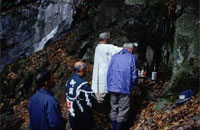
A waterfall is purified, and sanctified “waterfall water” is drawn for use in the yutate ritual.
(This ceremony serves as a misogii, or purification by water.)
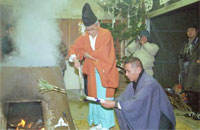
After the takibarai ceremony, the waterfall water is boiled for the water-boiling purification ritual, followed by a ceremony for the offering of prayers to the invited spirits.
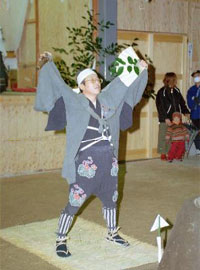
This dance is performed by youth carrying folding fans and bells.
Bamboo grass is carried when doing the dance in the Onyu style.
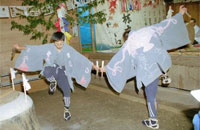
In this dance, two young dancers hold ritual props — folding fans, wooden swords, and metal swords — and stomp around the dance area hardening the ground.
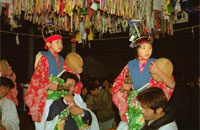
Children may participate in this dance from the ages of 3 or 4. The dance’s name, which means “flower dance,” comes from the headdresses decorated with flowers the dancers hold. In the Hana-no-mai, the folding fan, tray, or kettle that are held change as the children get older.
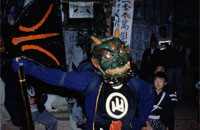
Yamami Oni is the first oni (friendly Japanese ogre) to appear. He splits the mountain and attempts to bring the dead back to life; this oni plays a vital role in the rebirth purification ritual. He places his foot on the cooking stove in the center of the dance area and performs the motions of splitting the mountain.
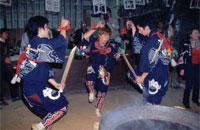
This dance involves three boys and uses the ritual props: folding fans, wooden swords, and metal swords. It is the next dance they learn after the Hana-no-mai, and it is more advanced.
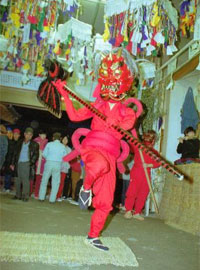
This oni is seen as the most important one, and is known to the locals as “the Great Sakaki.” The Sakaki Oni dances the henbe dance, infusing the earth with renewed life and vitality. The Sakaki Oni is also known for answering questions.
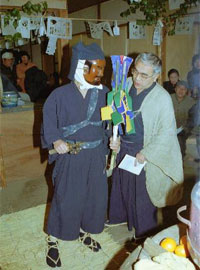
This dancer wears a negi mask and dances while holding a hino-negibei (wand with streamers) and bells. The Hino Negi participates in a dialogue with the other negi, and the dance includes water purification rituals.
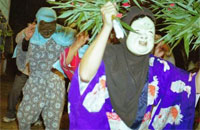
This dance is performed by a Miko, Okame (female dancers), and Hyottoko (male dancers) in masks. They enter the dance area with gohei-mochi (rice dumplings), surikogi (pestles), and shamoji (rice paddles) in hand, in order to confer blessings on the villagers. It is said to be a good omen for the year if one gets rice or miso (fermented soybean paste) on oneself.
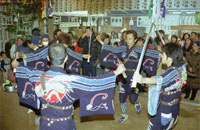
This performance, performed by four youths, is long and involves difficult dances, requiring physical strength and refined technique. A folding fan, wooden sword, and metal sword serve as the ritual props, but in some cases a cloak serves as the ritual prop for the folding fan dance.
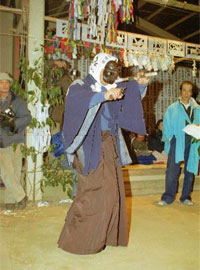
This dancer wears an Okina mask and dances with an okinabei wand and bells. He participates in a dialogue with the negi. This performance is always lively, as the two hold a comical exchange on the Okina’s place of birth, personal history, and life with his wife’s family, which the audience interrupts with playful banter.
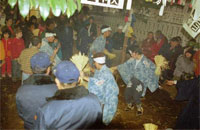
This dance has the fastest tempo, involving four boys who carry yutabusa (brushes made of bundled straw), and when the dance is over, hot water is sprinkled haphazardly all over the dance area in order to purify it. The water is welcomed by spectators, as getting the water on oneself will ward off illness.
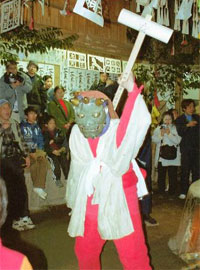
As part of his dance, this last oni knocks down the beehive (otakara) hanging from the yubuta (overhead canopy) with his mallet, and the spectators scramble for it as a good-luck talisman. The beehive contains purified coins and strips of paper in five colors.
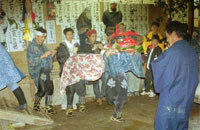
The stove-purification lion, also called the Lion of Purification, is the final dance of the Hana Matsuri. The Shishi (lion) appears to crawl around the dance area as it performs the purification dance.
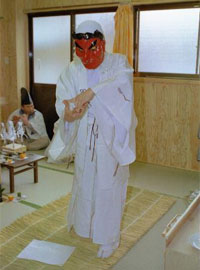
In this ceremony, the Hana Dayu (main ritual officiant) puts on a pacification mask and employs numerous means in order to placate violent and angry gods. (In some places, this ceremony involves two people.)








